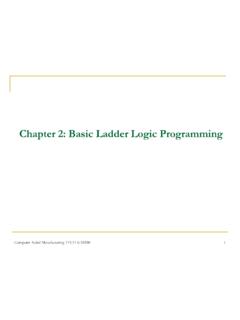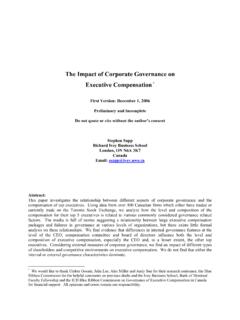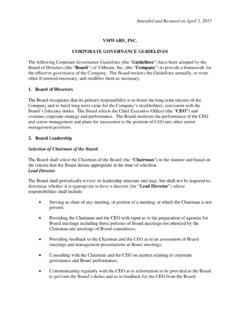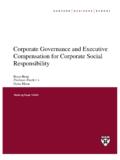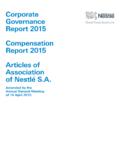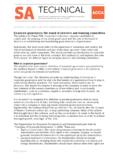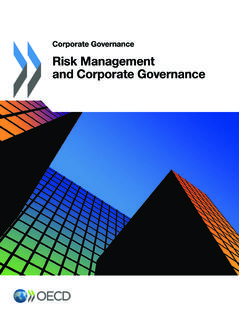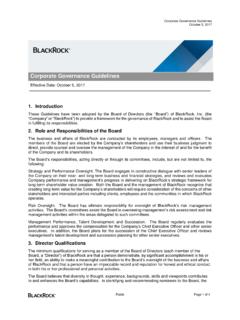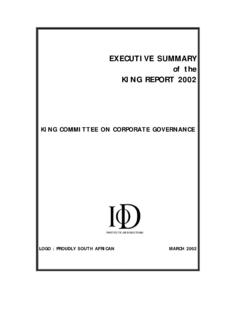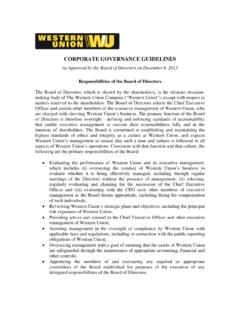Transcription of Corporate Governance - Kent State University
1 Slide 1 Copyright 2004 South-WesternAll rights slides by:R. Dennis MiddlemistColorado State UniversityChapter 10 Chapter 10 Chapter 10 Corporate GovernanceSlide 2 Copyright 2004 South-Western. All rights reserved. 10 2 Corporate Governance Corporate Governance is: A relationship among stakeholders used to determine and control the strategic direction and performance of organizations Concerned with making strategic decisions more effectively Used to establish order between a firm s owners and its top-level managers whose interests may be in conflictSlide 3 Copyright 2004 South-Western. All rights reserved. 10 3 Internal Governance Mechanisms Ownership Concentration Relative amounts of stock owned by individual shareholders and institutional investors Board of Directors Individuals responsible for representing the firm s owners by monitoring top-level managers strategic decisionsSlide 4 Copyright 2004 South-Western.
2 All rights reserved. 10 4 Internal Governance Mechanisms executive Compensation Use of salary, bonuses, and long-term incentives to align managers interests with shareholders interestsSlide 5 Copyright 2004 South-Western. All rights reserved. 10 5 External Governance Mechanisms Market for Corporate Control Purchase of a firm that is underperforming relative to industry rivals in order to improve its strategic competitivenessSlide 6 Copyright 2004 South-Western. All rights reserved. 10 6 Separation of Ownership and Managerial Control Basis of the Modern Corporation Shareholders purchase stock, becoming residual claimants Shareholders reduce risk by holding diversified portfolios Professional managers are contracted to provide decision makingSlide 7 Copyright 2004 South-Western. All rights reserved. 10 7 Separating Ownership and Managerial Control Modern public corporation form leads to efficient specialization of tasks: Risk bearing by shareholders Strategy development and decision making by managersSlide 8 Copyright 2004 South-Western.
3 All rights reserved. 10 8An Agency RelationshipFigure createSlide 9 Copyright 2004 South-Western. All rights reserved. 10 9 Agency Relationship Problems Principal and agent have divergent interests and goals Shareholders lack direct control of large, publicly traded corporations Agent makes decisions that result in the pursuit of goals that conflict with those of the principal It is difficult or expensive for the principal to verify that the agent has behaved appropriately Agent falls prey to managerial opportunismSlide 10 Copyright 2004 South-Western. All rights reserved. 10 10 Managerial Opportunism The seeking of self-interest with guile (cunning or deceit) Managerial opportunism is: An attitude (inclination) A set of behaviors (specific acts of self-interest) Managerial opportunism prevents the maximization of shareholder wealth (the primary goal of owner/principals)Slide 11 Copyright 2004 South-Western.
4 All rights reserved. 10 11 Response to Managerial Opportunism Principals do not know beforehand which agents will or will not act opportunistically Thus, principals establish Governance and control mechanisms to prevent managerial opportunismSlide 12 Copyright 2004 South-Western. All rights reserved. 10 12 Examples of the Agency Problem Possible Problems Product diversification Increased size, and relationship of size to managerial compensation Reduction of managerial employment risk Use of Free Cash Flows Managers prefer to invest these funds in additional product diversification (see above) Shareholders prefer the funds as dividends so they control how the funds are investedSlide 13 Copyright 2004 South-Western. All rights reserved. 10 13 Manager and Shareholder Risk and DiversificationFigure 14 Copyright 2004 South-Western. All rights reserved.
5 10 14 Agency Costs and Governance Mechanisms Principals may engage in monitoring behavior to assess the activities and decisions of managers However, dispersed shareholding makes it difficult and inefficient to monitor management s behavior Boards of Directors have a fiduciary duty to shareholders to monitor management However, Boards of Directors are often accused of being lax in performing this functionSlide 15 Copyright 2004 South-Western. All rights reserved. 10 15 Governance Mechanisms Large block shareholders have a strong incentive to monitor management closely: Their large stakes make it worth their while to spend time, effort and expense to monitor closely They may also obtain Board seats which enhances their ability to monitor effectively Financial institutions are legally forbidden from directly holding board seatsOwnershipOwnershipConcentration (a)Concentration (a)Slide 16 Copyright 2004 South-Western.
6 All rights reserved. 10 16 Governance Mechanisms (cont d) The increasing influence of institutional owners (stock mutual funds and pension funds) Have the size (proxy voting power) and incentive (demand for returns to funds) to discipline ineffective top-level managers Can affect the firm s choice of strategiesOwnershipOwnershipConcentratio n (b)Concentration (b)Slide 17 Copyright 2004 South-Western. All rights reserved. 10 17 Governance Mechanisms (cont d) Shareholder activism: Shareholders can convene to discuss corporation s direction If a consensus exists, shareholders can vote as a block to elect their candidates to the board Proxy fights There are limits on shareholder activism available to institutional owners in responding to activists tacticsOwnershipOwnershipConcentration (c)Concentration (c)Slide 18 Copyright 2004 South-Western. All rights reserved.
7 10 18 Governance Mechanisms (cont d) Board of directors Group of elected individuals that acts in the owners interests to formally monitor and control the firm s top-level executives Board has the power to: Direct the affairs of the organization Punish and reward managers Protect owners from managerial opportunismOwnershipOwnershipConcentrati onConcentrationBoard of DirectorsBoard of Directors(a)(a)Slide 19 Copyright 2004 South-Western. All rights reserved. 10 19 Governance Mechanisms (cont d) Composition of Boards: Insiders:the firm s CEO and other top-level managers Related Outsiders:individuals uninvolved with day-to-day operations, but who have a relationship with the firm Outsiders:individuals who are independent of the firm s day-to-day operations and other relationshipsOwnershipOwnershipConcentra tionConcentrationBoard of DirectorsBoard of Directors(b)(b)Slide 20 Copyright 2004 South-Western.
8 All rights reserved. 10 20 Governance Mechanisms (cont d) Criticisms of Boards of Directors include: Too readily approve managers self-serving initiatives Are exploited by managers with personal ties to board members Are not vigilant enough in hiring and monitoring CEO behavior Lack of agreement about the number of and most appropriate role of outside directorsOwnershipOwnershipConcentration ConcentrationBoard of DirectorsBoard of Directors(c)(c)Slide 21 Copyright 2004 South-Western. All rights reserved. 10 21 Governance Mechanisms (cont d) Enhancing the effectiveness of boards and directors: More diversity in the backgrounds of board members Stronger internal management and accounting control systems More formal processes to evaluate the board s performance Adopting a lead director role Changes in compensation of directorsOwnershipOwnershipConcentration ConcentrationBoard of DirectorsBoard of Directors(d)(d)Slide 22 Copyright 2004 South-Western.
9 All rights reserved. 10 22 Governance Mechanisms (cont d) Forms of compensation: Salary, bonuses, long-term performance incentives, stock awards, stock options Factors complicating executive compensation: Strategic decisions by top-level managers are complex, non-routine and affect the firm over an extended period Other variables affecting the firm s performance over timeOwnershipOwnershipConcentrationConce ntrationBoard of DirectorsBoard of DirectorsExecutiveExecutiveCompensation (a)Compensation (a)Slide 23 Copyright 2004 South-Western. All rights reserved. 10 23 Governance Mechanisms (cont d) Limits on the effectiveness of executive compensation: Unintended consequences of stock options Firm performance not as important than firm size Balance sheet not showing executive wealth Options not expensed at the time they are awardedOwnershipOwnershipConcentrationCo ncentrationBoard of DirectorsBoard of DirectorsExecutiveExecutiveCompensation (b)Compensation (b)Slide 24 Copyright 2004 South-Western.
10 All rights reserved. 10 24 Governance Mechanisms (cont d) Individuals and firms buy or take over undervalued corporations Ineffective managers are usually replaced in such takeovers Threat of takeover may lead firm to operate more efficiently Changes in regulations have made hostile takeovers difficultOwnershipOwnershipConcentration ConcentrationBoard of DirectorsBoard of DirectorsExecutiveExecutiveCompensationC ompensationMarket forMarket forCorporate Control (a) Corporate Control (a)Slide 25 Copyright 2004 South-Western. All rights reserved. 10 25 Governance Mechanisms (cont d) Managerial defense tactics increase the costs of mounting a takeover Defense tactics may require: Asset restructuring Changes in the financial structure of the firm Shareholder approval Market for Corporate control lacks the precision of internal Governance mechanismsOwnershipOwnershipConcentratio nConcentrationBoard of DirectorsBoard of DirectorsExecutiveExecutiveCompensationC ompensationMarket forMarket forCorporate Control (b) Corporate Control (b)Slide 26 Copyright 2004 South-Western.
